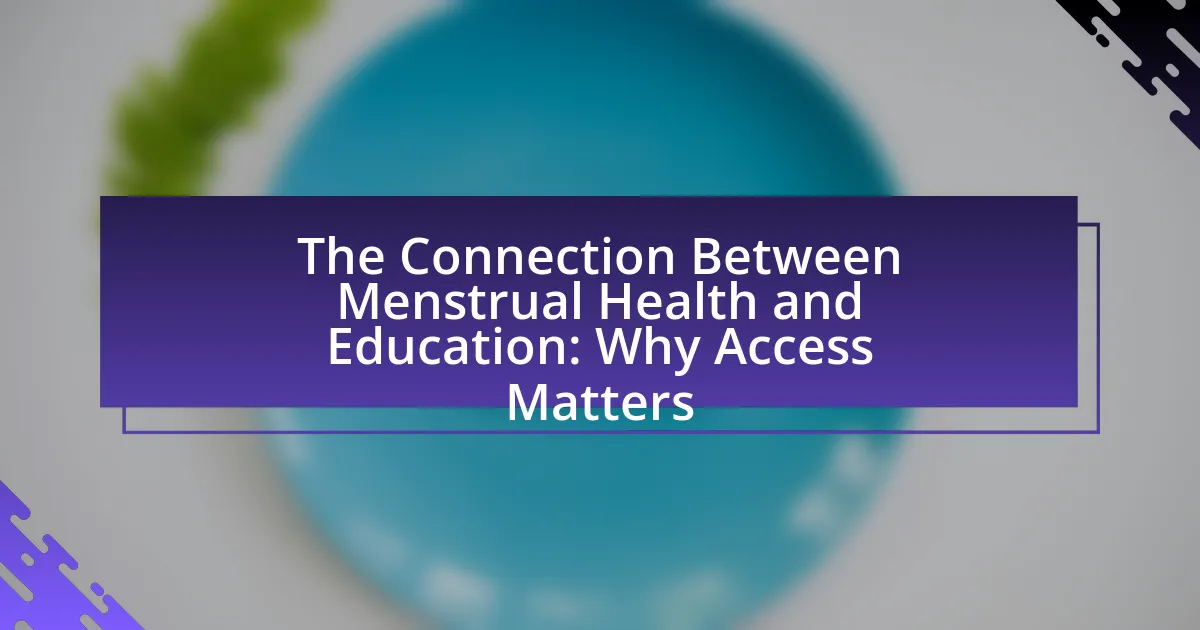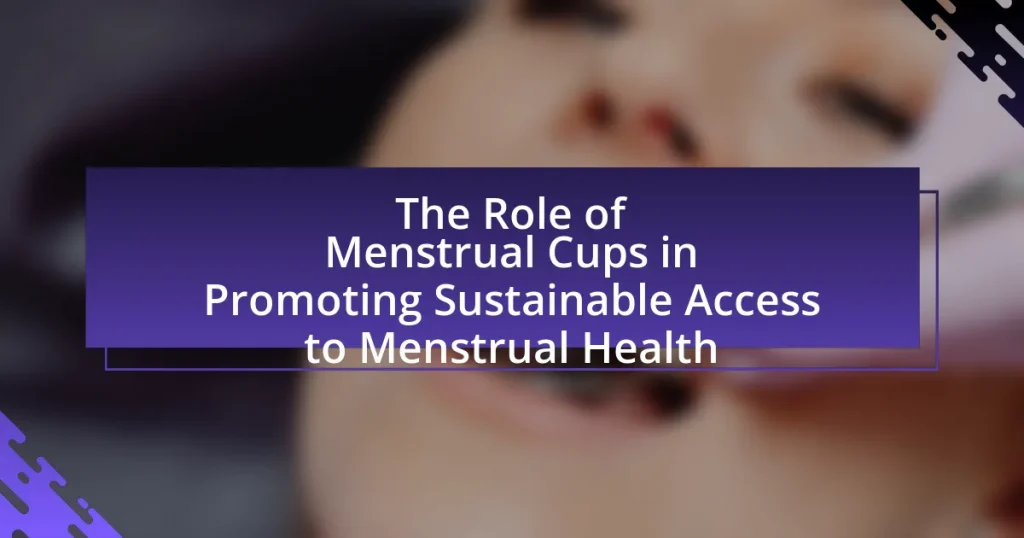The article explores the critical connection between menstrual health and education, emphasizing how access to education influences menstrual health management and awareness. It highlights research indicating that comprehensive menstrual health education leads to improved health outcomes, reduced stigma, and enhanced academic performance among students. The article discusses the impact of menstrual-related absenteeism on educational attainment, the importance of access to menstrual health resources, and the barriers that hinder effective education. Additionally, it addresses the role of cultural attitudes, societal norms, and systemic issues in shaping perceptions and access to menstrual health education, ultimately advocating for improved educational initiatives and resources to support students.

What is the connection between menstrual health and education?
Menstrual health and education are interconnected, as access to education significantly influences menstrual health management and awareness. Research indicates that girls who receive comprehensive education about menstrual health are more likely to manage their menstruation effectively, leading to improved health outcomes and reduced stigma. For instance, a study published in the journal “BMC Women’s Health” found that girls with access to menstrual health education reported higher levels of confidence and knowledge regarding their menstrual cycles, which directly correlates with better health practices. Furthermore, lack of education on this topic can lead to absenteeism in school, as girls may miss classes due to inadequate menstrual hygiene management, thereby impacting their overall educational attainment.
How does menstrual health impact educational outcomes?
Menstrual health significantly impacts educational outcomes by affecting attendance, participation, and academic performance among students. Research indicates that inadequate menstrual hygiene management can lead to increased absenteeism, with studies showing that girls may miss up to 20% of school days due to menstruation-related issues. For instance, a study published in the journal “Global Health: Science and Practice” found that girls in low-income countries often face barriers such as lack of access to sanitary products and private facilities, which directly correlates with lower educational attainment. Furthermore, the stigma surrounding menstruation can lead to psychological stress, further hindering academic engagement and performance.
What are the effects of menstrual-related absenteeism on students?
Menstrual-related absenteeism negatively impacts students by hindering their academic performance and social engagement. Research indicates that students who miss school due to menstrual issues often experience lower grades and reduced participation in class activities. A study published in the Journal of Adolescent Health found that approximately 14% of girls reported missing school due to menstrual pain, which correlates with decreased academic achievement and increased feelings of isolation. This absenteeism can lead to long-term educational disadvantages, affecting future opportunities and overall well-being.
How does access to menstrual health resources influence academic performance?
Access to menstrual health resources significantly enhances academic performance by reducing absenteeism and improving concentration during school hours. When students have access to menstrual products, education on menstrual health, and supportive environments, they are less likely to miss school due to menstrual-related issues. Research indicates that girls who lack access to menstrual hygiene products are 1.5 times more likely to miss school, which directly correlates with lower academic achievement. Furthermore, a study published in the journal “BMC Women’s Health” found that comprehensive menstrual health education leads to increased confidence and participation in school activities, further supporting academic success.
Why is education about menstrual health important?
Education about menstrual health is important because it empowers individuals with knowledge that promotes better health outcomes and reduces stigma. Understanding menstrual health enables individuals to manage their menstrual cycles effectively, recognize potential health issues, and seek appropriate medical care when necessary. Research indicates that comprehensive menstrual health education can lead to improved academic performance, as students who are informed about their menstrual health are less likely to miss school due to menstrual-related issues. Furthermore, studies show that education can significantly reduce the stigma surrounding menstruation, fostering a more supportive environment for those who menstruate.
What knowledge gaps exist regarding menstrual health among students?
Knowledge gaps regarding menstrual health among students include a lack of understanding of menstrual hygiene management, the biological processes of menstruation, and the socio-cultural stigmas associated with menstruation. Research indicates that many students are unaware of the importance of proper hygiene practices during menstruation, which can lead to health issues. For instance, a study published in the Journal of Adolescent Health found that 70% of girls in some regions lacked adequate knowledge about menstrual hygiene, impacting their health and school attendance. Additionally, misconceptions about menstruation persist, with many students believing harmful myths, which further exacerbates stigma and misinformation.
How can education reduce stigma surrounding menstruation?
Education can reduce stigma surrounding menstruation by providing accurate information and fostering open discussions about menstrual health. Comprehensive education programs that include topics on menstruation can demystify the biological processes involved, challenge cultural taboos, and promote understanding among all genders. Research indicates that when students receive education about menstruation, they are more likely to view it as a normal and healthy part of life, which can lead to decreased embarrassment and shame. For instance, a study published in the journal “BMC Women’s Health” found that educational interventions significantly improved knowledge and attitudes towards menstruation among adolescents, thereby reducing stigma.

What barriers exist to accessing menstrual health education?
Barriers to accessing menstrual health education include cultural stigma, lack of resources, and inadequate school curricula. Cultural stigma often leads to silence around menstruation, preventing open discussions and education. A lack of resources, such as trained educators and educational materials, further limits access, particularly in low-income areas. Additionally, many school curricula do not include comprehensive menstrual health education, resulting in gaps in knowledge for students. According to a study published in the Journal of Adolescent Health, 70% of girls reported feeling unprepared for menstruation due to insufficient education, highlighting the critical need for improved access to menstrual health education.
How do cultural attitudes affect menstrual health education?
Cultural attitudes significantly influence menstrual health education by shaping perceptions, beliefs, and practices surrounding menstruation. In many cultures, menstruation is stigmatized, leading to misinformation and a lack of open discussion, which hinders effective education. For instance, a study published in the Journal of Adolescent Health found that in societies where menstruation is viewed as taboo, girls often receive inadequate information, resulting in misconceptions about menstrual hygiene and health. This lack of education can lead to health issues and social isolation, demonstrating that cultural attitudes directly impact the quality and accessibility of menstrual health education.
What role do societal norms play in shaping perceptions of menstruation?
Societal norms significantly influence perceptions of menstruation by framing it as either a taboo subject or a natural biological process. In many cultures, menstruation is surrounded by stigma, leading to feelings of shame and embarrassment among individuals who menstruate. For instance, a study published in the journal “Reproductive Health” found that in various societies, negative attitudes towards menstruation can result in social isolation and hinder access to menstrual health education. These norms dictate how menstruation is discussed, often leading to misinformation and a lack of open dialogue, which can adversely affect menstrual health management and education.
How can cultural sensitivity improve menstrual health education initiatives?
Cultural sensitivity can significantly enhance menstrual health education initiatives by ensuring that the content is relevant and respectful to diverse cultural beliefs and practices surrounding menstruation. When educational programs acknowledge and incorporate local customs, language, and values, they are more likely to engage the target audience effectively. For instance, a study published in the Journal of Adolescent Health found that culturally tailored menstrual health education increased knowledge and reduced stigma among participants in various communities. This approach fosters trust and encourages open discussions, ultimately leading to improved health outcomes and greater acceptance of menstrual health education.
What systemic issues hinder access to menstrual health resources?
Systemic issues that hinder access to menstrual health resources include socio-economic barriers, lack of education, and inadequate healthcare infrastructure. Socio-economic barriers, such as poverty, limit individuals’ ability to afford menstrual products and healthcare services. According to a study by the World Bank, 1 in 10 girls in Africa misses school during their menstrual cycle due to a lack of access to sanitary products. Additionally, a lack of education about menstrual health perpetuates stigma and misinformation, leading to further isolation and inadequate self-care. Inadequate healthcare infrastructure, particularly in rural areas, restricts access to necessary medical advice and support, as highlighted by the United Nations Population Fund, which reports that many women in low-income countries lack access to basic reproductive health services. These systemic issues collectively create significant barriers to menstrual health resources.
How do economic factors influence access to menstrual products and education?
Economic factors significantly influence access to menstrual products and education by determining affordability and availability. Low-income households often struggle to purchase menstrual products, leading to missed school days for menstruating students; research indicates that 1 in 5 girls in the U.S. have missed school due to lack of access to these products. Additionally, schools in economically disadvantaged areas may lack the resources to provide education on menstrual health, perpetuating stigma and misinformation. This lack of access not only affects individual health but also hinders educational attainment, as students may fall behind academically due to absenteeism linked to menstruation.
What policies can be implemented to improve access to menstrual health resources?
To improve access to menstrual health resources, policies should include the provision of free menstrual products in schools and public facilities. Research indicates that when menstrual products are readily available, absenteeism among students decreases significantly, as evidenced by a study from the University of California, which found that 1 in 5 girls in the U.S. have missed school due to lack of access to these products. Additionally, implementing comprehensive menstrual health education in school curricula can empower students with knowledge about their bodies and reduce stigma. Countries like Scotland have already taken steps to provide free menstrual products, demonstrating a successful model for improving access.

How can we improve access to menstrual health education?
Improving access to menstrual health education can be achieved through integrating comprehensive curricula in schools, community workshops, and digital platforms. Research indicates that educational programs in schools significantly enhance knowledge and reduce stigma surrounding menstruation, as evidenced by a study published in the Journal of Adolescent Health, which found that students exposed to menstrual health education reported increased understanding and comfort discussing the topic. Additionally, leveraging technology, such as mobile apps and online resources, can reach wider audiences, particularly in underserved areas, thereby facilitating access to vital information.
What strategies can schools adopt to enhance menstrual health education?
Schools can enhance menstrual health education by implementing comprehensive curricula that include accurate information about menstruation, hygiene, and reproductive health. This approach ensures that students receive essential knowledge that demystifies menstruation and promotes healthy practices. Research indicates that comprehensive sex education, which includes menstrual health, leads to improved health outcomes and increased awareness among students. For instance, a study published in the Journal of Adolescent Health found that students who received comprehensive education reported higher levels of understanding and comfort discussing menstrual health topics. Additionally, schools can provide training for teachers to deliver this education effectively, ensuring that they are equipped to address students’ questions and concerns. By fostering an open and supportive environment, schools can significantly improve students’ understanding and management of menstrual health.
How can partnerships with health organizations support menstrual health education?
Partnerships with health organizations can significantly enhance menstrual health education by providing credible resources, expert knowledge, and outreach capabilities. These organizations often have established networks and access to diverse populations, allowing them to disseminate accurate information about menstrual health effectively. For instance, the World Health Organization emphasizes the importance of education in improving health outcomes, stating that informed individuals are better equipped to manage their health. Additionally, collaborations can lead to the development of tailored educational programs that address cultural sensitivities and specific community needs, thereby increasing engagement and understanding.
What role can parents and communities play in promoting menstrual health awareness?
Parents and communities play a crucial role in promoting menstrual health awareness by providing education, support, and resources. Parents can initiate open conversations about menstruation, helping to normalize the topic and reduce stigma, which is essential for young individuals to feel comfortable discussing their experiences. Communities can organize workshops and informational sessions that educate both genders about menstrual health, fostering a supportive environment. Research indicates that comprehensive menstrual health education can lead to improved health outcomes and increased school attendance among menstruating individuals, as seen in studies conducted by the World Bank, which highlight the positive impact of awareness programs on educational access.
What best practices can be implemented for effective menstrual health education?
Effective menstrual health education can be implemented through comprehensive curriculum integration, community engagement, and the use of accurate, culturally relevant materials. Comprehensive curriculum integration ensures that menstrual health is included in school health education programs, which has been shown to improve knowledge and reduce stigma among students. Community engagement involves parents, teachers, and healthcare providers in discussions and workshops, fostering a supportive environment for open dialogue. The use of accurate, culturally relevant materials is crucial, as studies indicate that educational resources tailored to specific cultural contexts enhance understanding and acceptance of menstrual health topics.
How can interactive and engaging teaching methods improve understanding of menstrual health?
Interactive and engaging teaching methods can significantly enhance understanding of menstrual health by promoting active participation and critical thinking among learners. These methods, such as group discussions, hands-on activities, and multimedia presentations, facilitate a deeper comprehension of menstrual health topics by allowing students to explore concepts in a dynamic environment. Research indicates that students who engage in interactive learning are more likely to retain information and apply it in real-life situations, as evidenced by a study published in the Journal of Educational Psychology, which found that active learning strategies improved knowledge retention by up to 50%. By fostering an inclusive and supportive atmosphere, these teaching methods also encourage open dialogue about menstrual health, reducing stigma and misinformation, ultimately leading to better health outcomes and informed decision-making.
What resources are available for educators to teach menstrual health effectively?
Educators can access a variety of resources to teach menstrual health effectively, including comprehensive curricula, online training modules, and community workshops. For instance, organizations like the American College of Obstetricians and Gynecologists provide educational materials that cover the biological, emotional, and social aspects of menstruation. Additionally, platforms such as the Menstrual Health Hub offer free resources, including lesson plans and infographics, designed specifically for educators. Research indicates that comprehensive menstrual health education can improve students’ understanding and attitudes towards menstruation, leading to better health outcomes and reduced stigma.
What are practical steps to ensure all students have access to menstrual health education?
To ensure all students have access to menstrual health education, schools should implement comprehensive curricula that include age-appropriate information about menstruation, reproductive health, and hygiene. This can be achieved by training educators to deliver this content effectively, integrating menstrual health education into existing health classes, and providing resources such as pamphlets and online materials.
Research indicates that comprehensive sexual education, which includes menstrual health, leads to better health outcomes for students. For instance, a study published in the Journal of Adolescent Health found that students who received comprehensive sexual education were more likely to report understanding their bodies and menstrual cycles. Additionally, schools can partner with local health organizations to provide workshops and resources, ensuring that all students, regardless of gender, receive the necessary information.



